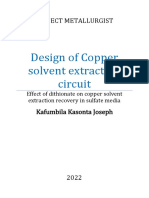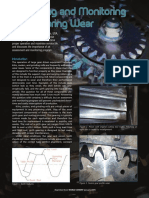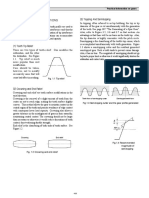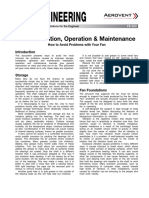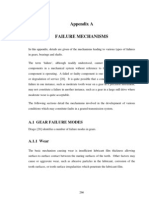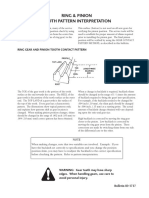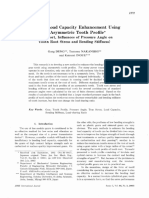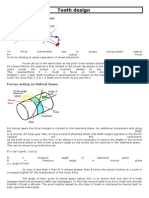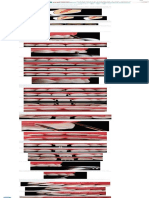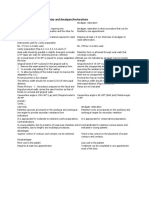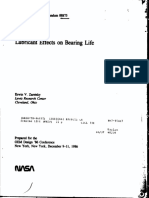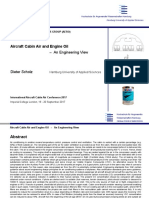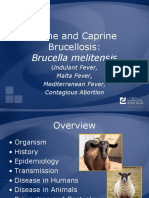0 ratings0% found this document useful (0 votes)
26 views419 PDF
419 PDF
Uploaded by
arda akkayaGear tooth modifications are used to avoid excessive load, interference, and noise. There are several types of modifications:
1) Tooth tip relief modifies the addendum or dedendum to reduce the tooth tip diameter and prevent interference.
2) Crowning removes a slight amount of material from the center of the tooth to the edges, making the surface convex and allowing for central contact under misalignment.
3) End relief chamfers the ends of each tooth to similar effects and allows for greater tolerance in assembly.
4) Topping and semitopping cut the top or corners of the tooth simultaneously during generation for a burr-free surface and concentric pitch diameter. Semitop
Copyright:
© All Rights Reserved
Available Formats
Download as PDF, TXT or read online from Scribd
419 PDF
419 PDF
Uploaded by
arda akkaya0 ratings0% found this document useful (0 votes)
26 views1 pageGear tooth modifications are used to avoid excessive load, interference, and noise. There are several types of modifications:
1) Tooth tip relief modifies the addendum or dedendum to reduce the tooth tip diameter and prevent interference.
2) Crowning removes a slight amount of material from the center of the tooth to the edges, making the surface convex and allowing for central contact under misalignment.
3) End relief chamfers the ends of each tooth to similar effects and allows for greater tolerance in assembly.
4) Topping and semitopping cut the top or corners of the tooth simultaneously during generation for a burr-free surface and concentric pitch diameter. Semitop
Original Title
419.pdf
Copyright
© © All Rights Reserved
Available Formats
PDF, TXT or read online from Scribd
Share this document
Did you find this document useful?
Is this content inappropriate?
Gear tooth modifications are used to avoid excessive load, interference, and noise. There are several types of modifications:
1) Tooth tip relief modifies the addendum or dedendum to reduce the tooth tip diameter and prevent interference.
2) Crowning removes a slight amount of material from the center of the tooth to the edges, making the surface convex and allowing for central contact under misalignment.
3) End relief chamfers the ends of each tooth to similar effects and allows for greater tolerance in assembly.
4) Topping and semitopping cut the top or corners of the tooth simultaneously during generation for a burr-free surface and concentric pitch diameter. Semitop
Copyright:
© All Rights Reserved
Available Formats
Download as PDF, TXT or read online from Scribd
Download as pdf or txt
0 ratings0% found this document useful (0 votes)
26 views1 page419 PDF
419 PDF
Uploaded by
arda akkayaGear tooth modifications are used to avoid excessive load, interference, and noise. There are several types of modifications:
1) Tooth tip relief modifies the addendum or dedendum to reduce the tooth tip diameter and prevent interference.
2) Crowning removes a slight amount of material from the center of the tooth to the edges, making the surface convex and allowing for central contact under misalignment.
3) End relief chamfers the ends of each tooth to similar effects and allows for greater tolerance in assembly.
4) Topping and semitopping cut the top or corners of the tooth simultaneously during generation for a burr-free surface and concentric pitch diameter. Semitop
Copyright:
© All Rights Reserved
Available Formats
Download as PDF, TXT or read online from Scribd
Download as pdf or txt
You are on page 1of 1
Practical Information on gears
1 GEAR TOOTH MODIFICATIONS (3) Topping And Semitopping
In topping, often referred to as top hobbing, the top or tip
Intentional deviations from the involute tooth profile are used to diameter of the gear is cut simultaneously with the generation
avoid excessive tooth load deflection interference and thereby of the teeth. See page 387 "The Generating of a Spur Gear".
enhances load capacity. Also, the elimination of tip interference Also, refer to Figure 3.5, 3.6 and 3.7 in that section. An
reduces meshing noise. Other modifications can accommodate advantage is that there will be no burrs on the tooth top. Also,
assembly misalignment and thus preserve load capacity. the tip diameter is highly concentric with the pitch circle.
Semitopping is the chamfering of the tooth's top corner, which
is accomplished simultaneously with tooth generation. Figure
(1) Tooth Tip Relief
1.3 shows a semitopping cutter and the resultant generated
There are two types of tooth relief. One modifies the semitopped gear. Such a tooth tends to prevent corner damage.
addendum, and the other Also, it has no burr. The magnitude of semitopping should not go
the dedendum. See Figure beyond a proper limit as otherwise it would significantly shorten the
1.1. Tip relief is much addendum and contact ratio.
more popular than root
modification.
Care should be taken,
however, not to modify
excessively since that will
cause bad effect in meshing. Fig. 1.1 Tip relief
Figure 1.4 specifies a recommended magnitude of semitopping
(2) Crowning and End Relief They are independent modifications but, if desired, can be
applied simultaneously.
Crowning and end relief are tooth surface modifications in the
axial direction.
Crowning is the removal of a slight amount of tooth from the Teeth form of semitopping cutter Semitopped teeth form
center on out to reach edge, making the tooth surface slightly
Fig.1.3 Semitopping cutter and the gear profile generated
convex. This method allows the gear to maintain contact in the
central region of the tooth and permits avoidance of edge contact
with consequent lower load capacity. Crowning also allows a
greater tolerance in the misalignment of gears in their assembly,
maintaining central contact. The crowning should not be larger
than necessary as otherwise it would reduce dimentions of tooth
0.1m
contact, thus weakening durable strength.
End relief is the chamfering of both ends of tooth surface. See
90°-α
Figure 1.2.
2
Crowning End relief
Fig.1.4 Recommended
magnitude of
semitopping
Fig. 1.2 Crowning and end relief
419
You might also like
- The Heat Will Kill You FirstDocument16 pagesThe Heat Will Kill You FirstWBUR71% (7)
- Beyond TelepathyDocument364 pagesBeyond Telepathyneonpanther94% (18)
- Design of Copper Solvent Extraction Circuit - Effect of Dithionate On Copper Solvent Extraction RecoveryDocument148 pagesDesign of Copper Solvent Extraction Circuit - Effect of Dithionate On Copper Solvent Extraction Recoveryjoseph kafumbilaNo ratings yet
- Girth Gear Wear PDFDocument6 pagesGirth Gear Wear PDFRajib DuttaNo ratings yet
- The Egg - by Andy WeirDocument3 pagesThe Egg - by Andy Weirsrg012No ratings yet
- BUY Sell StockfinzDocument3 pagesBUY Sell Stockfinzvikas100% (1)
- Gear Tooth Modifications: Fig. 1.1 Tip ReliefDocument1 pageGear Tooth Modifications: Fig. 1.1 Tip ReliefJuanNo ratings yet
- Gear-Tip Relief PDFDocument1 pageGear-Tip Relief PDFSyedNo ratings yet
- Gear Guide2Document50 pagesGear Guide2Anonymous fQAeGFNo ratings yet
- 1.10 Tooth-Profile-Modification TechinicalData KGSTOCKGEARSDocument2 pages1.10 Tooth-Profile-Modification TechinicalData KGSTOCKGEARSJuanNo ratings yet
- Engranajes 7Document2 pagesEngranajes 7Walter PradaNo ratings yet
- Maag, Tooth F Lank ModificationsDocument8 pagesMaag, Tooth F Lank ModificationsPeter CardenNo ratings yet
- Gear Tooth ProfileDocument5 pagesGear Tooth ProfilepremnathgopinathanNo ratings yet
- DUDLEYs HANDBOOK OF PRACTICAL GEAR DESIG Part185Document1 pageDUDLEYs HANDBOOK OF PRACTICAL GEAR DESIG Part185Minh Sơn - HNNo ratings yet
- Effects of Profile Corrections On Peak-to-Peak Transmission ErrorDocument10 pagesEffects of Profile Corrections On Peak-to-Peak Transmission ErrorcoroNo ratings yet
- Tooth Design: Forces Acting On Spur GearsDocument8 pagesTooth Design: Forces Acting On Spur GearsMeghanath AdkonkarNo ratings yet
- Design of Involute Gear ToothDocument11 pagesDesign of Involute Gear ToothSahil KumarNo ratings yet
- Back To Basics PDFDocument11 pagesBack To Basics PDFVikas Mani TripathiNo ratings yet
- DUDLEYs HANDBOOK OF PRACTICAL GEAR DESIG Part188Document1 pageDUDLEYs HANDBOOK OF PRACTICAL GEAR DESIG Part188Minh Sơn - HNNo ratings yet
- Principles of Tooth PreparationDocument10 pagesPrinciples of Tooth Preparationruchika100% (2)
- GearsDocument78 pagesGearsL.K. Bhagi100% (1)
- Involute Splines, BasicsDocument12 pagesInvolute Splines, Basicsewillia13No ratings yet
- Unit - I Spur Gear: by Prof. Surendrasingh Y. SonayeDocument10 pagesUnit - I Spur Gear: by Prof. Surendrasingh Y. SonayeSurendra SonayeNo ratings yet
- 4Angrenaje1Engleza PDFDocument10 pages4Angrenaje1Engleza PDFGabriel IulianNo ratings yet
- PFM (Anterior) Crown Restorationsc Advantagesc: CCCCCCC CCCCCCCDocument2 pagesPFM (Anterior) Crown Restorationsc Advantagesc: CCCCCCC CCCCCCCramitamimNo ratings yet
- Gear and Gear Unit DesignDocument22 pagesGear and Gear Unit Designaditya v s sNo ratings yet
- Module4gears 190328033613Document39 pagesModule4gears 190328033613Obaid KhanNo ratings yet
- Gear ContactDocument3 pagesGear ContactAli Ali AsjariNo ratings yet
- How To Avoid Problems With Your Fan FE 500Document8 pagesHow To Avoid Problems With Your Fan FE 500Javier VespaNo ratings yet
- Failure MechanismsDocument14 pagesFailure Mechanismsho-faNo ratings yet
- Stress Analysis of Bevel Gear Tool, Using FEA Tool ANSYS V.14Document6 pagesStress Analysis of Bevel Gear Tool, Using FEA Tool ANSYS V.14IjrtsNo ratings yet
- Lecture 3Document57 pagesLecture 3Saurabh KNo ratings yet
- Toothed Gears - Spur GearsDocument38 pagesToothed Gears - Spur GearsHarshal RodgeNo ratings yet
- High Speed Gears-Design and Application by James R. PartridgeDocument10 pagesHigh Speed Gears-Design and Application by James R. PartridgeAbbasAnsariNo ratings yet
- 2 2 PDFDocument14 pages2 2 PDFmgualdiNo ratings yet
- DCPSB5Document9 pagesDCPSB5Ludwin Alex Gutierrez Tinta100% (1)
- Couplings PDFDocument48 pagesCouplings PDFBudi SantosoNo ratings yet
- GearDocument31 pagesGearzaheer100% (2)
- Spur GearDocument29 pagesSpur GearNitin B maskeNo ratings yet
- Pergamon: Engineering Failure Analysis, Vol. 3, No. 3, Pp. 219-225, 1996Document7 pagesPergamon: Engineering Failure Analysis, Vol. 3, No. 3, Pp. 219-225, 1996sadeghiNo ratings yet
- Roller BitDocument16 pagesRoller BitRebar KakaNo ratings yet
- Friction Wheels: Toothed GearingDocument23 pagesFriction Wheels: Toothed GearingAnmolNo ratings yet
- Guidelines For Reusable Parts and Salvage Operations of Camshafts Visual Inspection of Timing GearDocument6 pagesGuidelines For Reusable Parts and Salvage Operations of Camshafts Visual Inspection of Timing GearsughieantoNo ratings yet
- Dana Ring and Pinion PatternDocument2 pagesDana Ring and Pinion PatternMohammed gNo ratings yet
- japonesesCR PDFDocument7 pagesjaponesesCR PDFJavier Antonio Cardenas OliverosNo ratings yet
- Tooth Design: Forces Acting On Spur GearsDocument77 pagesTooth Design: Forces Acting On Spur GearsJitendra KumarNo ratings yet
- Principles of Tooth Preparation Part-6Document1 pagePrinciples of Tooth Preparation Part-6Popper DyNo ratings yet
- Gears and Screw Threads PDFDocument16 pagesGears and Screw Threads PDFAnonymous hlRLVcMNo ratings yet
- Part SolutionDocument5 pagesPart SolutionCherrydhelNo ratings yet
- Shaft Alignment On PumpsDocument1 pageShaft Alignment On PumpsTuanbk NguyenNo ratings yet
- AGMA Technical PaperDocument14 pagesAGMA Technical PaperLuis TestaNo ratings yet
- Perbedaan Preparasi Komposit Dan Amalgam Class IDocument6 pagesPerbedaan Preparasi Komposit Dan Amalgam Class Ipasha intanNo ratings yet
- Gear DesignDocument67 pagesGear DesignrobineNo ratings yet
- AN Ngineering: Fan Installation, Operation & MaintenanceDocument8 pagesAN Ngineering: Fan Installation, Operation & MaintenanceAvery OppegardNo ratings yet
- Development and Application of A New Roller Cone Bit With Optimized Tooth OrientationDocument15 pagesDevelopment and Application of A New Roller Cone Bit With Optimized Tooth OrientationpendexxNo ratings yet
- Shaft Deflection Runout Vibration and Axial MotionDocument21 pagesShaft Deflection Runout Vibration and Axial MotionMohd Ridzuan AhmadNo ratings yet
- Differences Between The Inlay and AmalgamDocument1 pageDifferences Between The Inlay and AmalgamSkAliHassan100% (4)
- Beach PDFDocument8 pagesBeach PDFarda akkayaNo ratings yet
- Face Gears: Geometry and Strength: Ulrich Kissling and Stefan BeermannDocument8 pagesFace Gears: Geometry and Strength: Ulrich Kissling and Stefan BeermannbennyfergusonNo ratings yet
- Interceptive Orthodontics: A Practical Guide to Occlusal ManagementFrom EverandInterceptive Orthodontics: A Practical Guide to Occlusal ManagementNo ratings yet
- Cylindrical Compression Helix Springs For Suspension SystemsFrom EverandCylindrical Compression Helix Springs For Suspension SystemsNo ratings yet
- Metalwork and Machining Hints and Tips for Home Machinists: 101 Plans and DrawingsFrom EverandMetalwork and Machining Hints and Tips for Home Machinists: 101 Plans and DrawingsNo ratings yet
- Bearings And Bearing Metals: A Treatise Dealing with Various Types of Plain Bearings, the Compositions and Properties of Bearing Metals, Methods of Insuring Proper Lubrication, and Important Factors Governing the Design of Plain BearingsFrom EverandBearings And Bearing Metals: A Treatise Dealing with Various Types of Plain Bearings, the Compositions and Properties of Bearing Metals, Methods of Insuring Proper Lubrication, and Important Factors Governing the Design of Plain BearingsRating: 4 out of 5 stars4/5 (1)
- Standard Internal Circlip - DIN 472: Standard Material: Carbon Spring Steel Standard Finish: Black and OilDocument3 pagesStandard Internal Circlip - DIN 472: Standard Material: Carbon Spring Steel Standard Finish: Black and Oilarda akkayaNo ratings yet
- Ads 43a HDBK PDFDocument67 pagesAds 43a HDBK PDFarda akkayaNo ratings yet
- Mesh PDFDocument5 pagesMesh PDFarda akkayaNo ratings yet
- Beach PDFDocument8 pagesBeach PDFarda akkayaNo ratings yet
- ME311 Machine Design: Lecture 8: CylindersDocument15 pagesME311 Machine Design: Lecture 8: Cylindersarda akkayaNo ratings yet
- Aircraft Engine Blade-Out Dynamics: 7 International LS-DYNA Users Conference Drop/Impact SimulationDocument10 pagesAircraft Engine Blade-Out Dynamics: 7 International LS-DYNA Users Conference Drop/Impact Simulationarda akkayaNo ratings yet
- Dynamic Loads Acting On Engine Frame Elements After Fan Blade Out Event StudyDocument7 pagesDynamic Loads Acting On Engine Frame Elements After Fan Blade Out Event Studyarda akkayaNo ratings yet
- Flowchart For Selecting A Ball Spline: Selection StartsDocument23 pagesFlowchart For Selecting A Ball Spline: Selection Startsarda akkayaNo ratings yet
- Using Coiled Spring-Pin Hinges: Fastening and Joining Technology GuideDocument3 pagesUsing Coiled Spring-Pin Hinges: Fastening and Joining Technology Guidearda akkayaNo ratings yet
- Influence of Radial Interference On Torque Capacity of Shrink-Fit CamshaftDocument10 pagesInfluence of Radial Interference On Torque Capacity of Shrink-Fit Camshaftarda akkayaNo ratings yet
- Lubricant Effects On Bearing Life: Erwinv. ZarmkyDocument22 pagesLubricant Effects On Bearing Life: Erwinv. Zarmkyarda akkayaNo ratings yet
- What Differentiates Coiled Pins?: Prior To InstallationDocument2 pagesWhat Differentiates Coiled Pins?: Prior To Installationarda akkayaNo ratings yet
- AERO PRE GCAQE2017 CabinAirAndEngineOil 17-09-19Document72 pagesAERO PRE GCAQE2017 CabinAirAndEngineOil 17-09-19arda akkayaNo ratings yet
- Selection Criteria O-Ring PDFDocument1 pageSelection Criteria O-Ring PDFarda akkayaNo ratings yet
- Design and Modal Analysis To Calculate Critical Speed of ShaftDocument7 pagesDesign and Modal Analysis To Calculate Critical Speed of Shaftarda akkayaNo ratings yet
- EY Ripe For Investment The Indonesian Health Care Industry Post Introduction of Universal Health CoverageDocument76 pagesEY Ripe For Investment The Indonesian Health Care Industry Post Introduction of Universal Health CoverageIka Wulan PermataNo ratings yet
- (ND) Impact of Entrepreneurship Development in The Economic Development of Enugu State (A Case Study of Some Selected Firms in Enugu State)Document67 pages(ND) Impact of Entrepreneurship Development in The Economic Development of Enugu State (A Case Study of Some Selected Firms in Enugu State)Clifford JudeNo ratings yet
- CCNA 2 RSE Practice Skills Assessment v5Document11 pagesCCNA 2 RSE Practice Skills Assessment v5Hermo MedranoNo ratings yet
- Brochure-NSE-CFAP - Certified Stock Market Forensic AccountantDocument10 pagesBrochure-NSE-CFAP - Certified Stock Market Forensic AccountantvinothdeviNo ratings yet
- The Trinity in The Name of God, Elohim - Jesus Holy Spirit Jewish Messiah BibleDocument3 pagesThe Trinity in The Name of God, Elohim - Jesus Holy Spirit Jewish Messiah BiblerahmanNo ratings yet
- Metaeconomía: Telos Y Techne. Sobre El Principio de EscasezDocument9 pagesMetaeconomía: Telos Y Techne. Sobre El Principio de EscasezLUIS ALBERTO SUAREZ ROJASNo ratings yet
- Phrasal Verbs About Pandemics: Phrasal Verb Mix and Match Test 1Document10 pagesPhrasal Verbs About Pandemics: Phrasal Verb Mix and Match Test 1Maier OlimpiuNo ratings yet
- The Strange Affair of Robin NgangomDocument11 pagesThe Strange Affair of Robin NgangomManya Suri100% (1)
- Band Publicist List Denver Riot Fest 2014Document4 pagesBand Publicist List Denver Riot Fest 2014Nappy The PlugNo ratings yet
- Brucellosis BmelitensisDocument38 pagesBrucellosis Bmelitensisalvaro acNo ratings yet
- Why and How to-WPS OfficeDocument8 pagesWhy and How to-WPS OfficeJona MempinNo ratings yet
- Vol 9 - Magnetism, Electricity & Electronics PDFDocument415 pagesVol 9 - Magnetism, Electricity & Electronics PDFjoethompson007No ratings yet
- Lesson 45Document34 pagesLesson 45bhira1205No ratings yet
- BI Y6 LP TS25 (Unit 7 - Music and Song - LP 97 - 112)Document17 pagesBI Y6 LP TS25 (Unit 7 - Music and Song - LP 97 - 112)sitarasharhan1973_28No ratings yet
- Mastering The GMAT Focus Edition: Everything You Need To KnowDocument7 pagesMastering The GMAT Focus Edition: Everything You Need To KnowManya EducationNo ratings yet
- Dilg ReportDocument13 pagesDilg ReportCarol F NalusNo ratings yet
- Diamond Pharmacy LTD - Business PlanDocument15 pagesDiamond Pharmacy LTD - Business PlanEbai A. Ayuk NkemNo ratings yet
- I. Page. 12 (Student's Book) (45 Points)Document6 pagesI. Page. 12 (Student's Book) (45 Points)JavierNo ratings yet
- Curriculum Vitae Of: Contact AddressDocument3 pagesCurriculum Vitae Of: Contact AddressOli UllaNo ratings yet
- Quo Warranto CaseDocument27 pagesQuo Warranto CaseBarrrMaidenNo ratings yet
- Why Do People ConformDocument21 pagesWhy Do People ConformABDOULIENo ratings yet
- Summative Assignment and RubricDocument3 pagesSummative Assignment and Rubricapi-509660639No ratings yet
- Tesla Symp06 CorumDocument7 pagesTesla Symp06 CorumNO,NO,NO 2 status QUONo ratings yet
- Religiosity and Morality in Contemporary Churches in NigeriaDocument20 pagesReligiosity and Morality in Contemporary Churches in NigeriaPastor(Dr) Dele Alaba Ilesanmi, PhDNo ratings yet
- Constitutional Law NotesDocument80 pagesConstitutional Law NotesTathagata DuttaNo ratings yet


